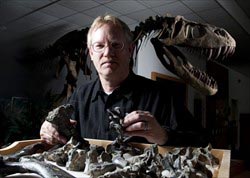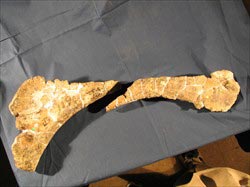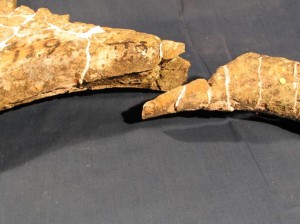Crushed Fossil Bones – Sauropods and Iguanodontids Passed This Way
Crushed Fossil Bones from Site in Utah Reveal Dinosaur Stomping Ground
Fossilised dinosaur bones can reveal a great deal about the anatomy of a particular dinosaur. A bonebed containing many hundreds of bones from a single species such as ceratopsisan bonebeds in North America (horned dinosaurs) can also provide information on herding behaviour. However, a dig site in Utah (United States) is providing palaeontologists with a window into the past revealing evidence of a very gruesome scene.
Fossilised Dinosaur Bones
A meticulous study of an extensive fossiliferous site near the town of Moab in the east of Utah, close to the Colorado state line, is providing scientists from Brigham Young University with an insight into dinosaur behaviour as a lake dried out and dinosaurs died in their hundreds. Many other larger dinosaurs, very possibly huge, long-necked and heavy sauropods then trampled the dead and dying animals as they made their way to the rapidly shrinking lake in order to quench their thirst.
This is the scene revealed by the painstaking study of thousands of dinosaur bones by geologists at Brigham Young University. It is reported in the scientific journal “Palaeo”.
Eight Differen Species!
So far the researchers have identified 67 individual dinosaurs representing 8 species – and they have only scratched the surface of this diverse quarry. Mysteriously, nearly all of the 4,200 bones recovered so far are fractured, but not broken up as a result of millions of years of fossilisation and preservation, these bones were snapped and shattered when they had lain on the ground and were relatively fresh.
Lead author on the study, Brigham Young University, Professor Brooks Britt stated:
“Although enough bones were recovered to assemble several complete dinosaurs, the vast majority of bones are broken to bits and pieces, just pulverised”.
Professor Brooks Britt of Brigham Young University

Picture credit: Brigham Young University (BYU)
The dinosaur fossil site, located to the west of the Arches National Park, contains dinosaurs of all sizes and ages, indicating a massive localised extinction event. The location of the bones, near the shore of an ancient lake bed, suggests that a severe drought was the cause.
What puzzled the scientists was what caused all the fractures. A closer analysis revealed that most of the breaks were angled “greenstick” fractures, reminiscent of those seen when fresh bones are snapped.
Brittle Bones
These dinosaur bones broke before they became brittle.
“Some of these bones were almost 5 feet long, and they are green, and you really have to work hard to shatter bone that’s still green. That means the big boys were stepping on those things, there would have been audible, big snaps”.
Professor Brooks Britt commented.
As the fossil site has been dated to approximately 100 million years ago (Albian faunal stage), the scientists cannot be certain what caused and pulverised the bones, however, large herds of huge sauropods would have have been likely culprits, aided and abetted by the smaller iguanodontids. A single Iguanodon might have weighed as much as 5 tonnes, no where near the size of a sauropod, but a herd of hundreds all moving towards the lake site would have caused a great deal of damage.
One of the Fractured Dinosaur Bones (Venenosaurus)
Picture credit: Brigham Young University (BYU)
A Close up of the Fractured Venenosaurus Bone
Picture credit: Brigham Young University
The white substance in the picture is the resin used to fix the fractures together, as the palaeontologists excavate the bones, but this hip bone has been stepped upon and broken at an acute angle, evidence of the break being made when the bone was relatively fresh.
Some of the bones from this dig site are housed at the Brigham Young University’s Earth Science Museum, they will no doubt form part of the many exhibits that are planned to go on display over the next few months.
Our thanks to Ashley Fickenwirth of Brigham Young University Communications Department for passing on this information and for the pictures.
For models of prehistoric animals including many dinosaur figures representing extinct animals once found in America: Dinosaur Models and Figures.



